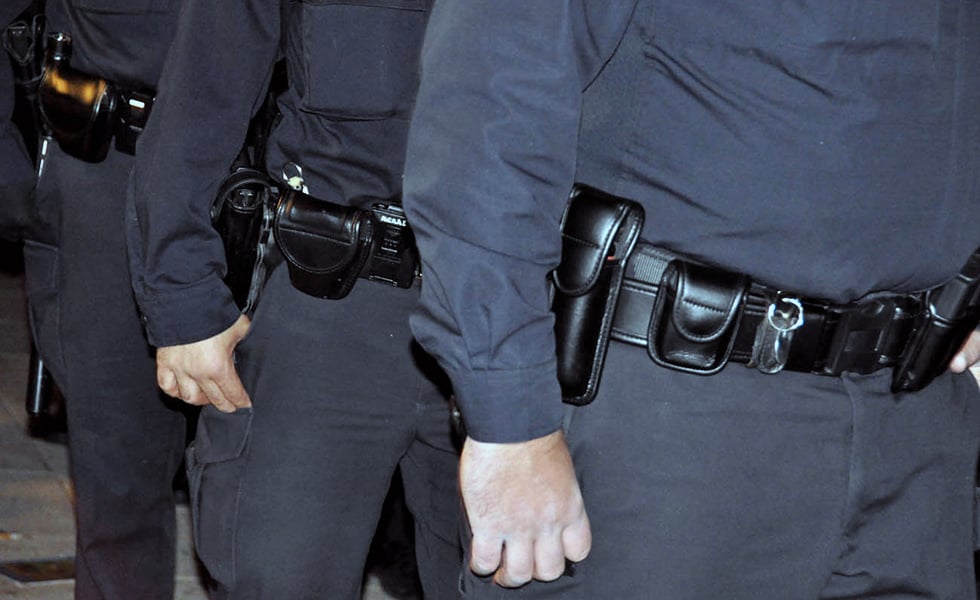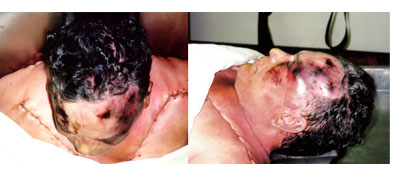
Are You Experienced?
Video of a Police Killing Produces Shockwaves in Baytown
Above: Documentation of police misconduct has never been as close as a VCR.
I know, I know you probably scream and cry
That your little world won’t let you go
But who in your measly little world
Are you trying to prove that
You’re made out of gold, and eh, can’t be sold.
So are you experienced?
Have you ever been experienced?
Well, I have.
—Jimi Hendrix
To view video, go to http://police.baytown.org/012002_5.html
We will never know if Luis Alfonso Torres heard these lyrics as they poured out of Baytown Police Officer Bert Dillow’s open squad car about half past midnight on Sunday January 20. We cannot ask him. Seven minutes later, Torres was dead, lying on the street, his hands cuffed behind his back, the left side of his head turning purple from the beating he had just received from three of Baytown’s finest.
Chances are Torres wouldn’t have recogized the Hendrix song anyway. Not necessarily because the 45-year-old sheet metal and insulation worker hailed from a small town in the western Mexican state of Jalisco or that he didn’t speak much English. Torres probably wouldn’t have understood because when Officers Dillow, Micah Aldred, and Sargent Rodney Evans came upon him, he was a sick man, incoherent, and suffering from hypertension.
Torres had in fact spent five hours the previous morning in a local hospital. Later that evening, he had wandered off in a daze, after refusing treatment from an ambulance team. At the time of his death, the officers responsible knew they had an unarmed man with a possible medical condition on their hands, but the Baytown Police have no procedures in place for handling mentally unstable or physically ill suspects. In a bitter irony, catty-corner from where the patrolmen stopped him on South Main Street was a building that housed the city’s Emergency Medical Service. The medical staff weren’t summoned until it was too late to repair what the coroner called death by “mechanical asphyxiation with blunt impact trauma.”

How Torres–who had no illegal drugs or alcohol in his system, carried no weapon, didn’t run, or even resist until after he had been thrown to the ground–had the life squeezed out of him by three policemen can be seen on a remarkable video taken by a camera mounted on Officer Dillow’s squad car.
“It’s bigger than the Rodney King video,” notes one Houston-based Hispanic activist. “After all, in this incident someone died.”
Unfortunately, the camera is roughly fifteen feet away and the picture is dark, grainy, and often hard to see. It’s difficult to determine certain nuances: For instance, at what point exactly did they pepper spray him? Which officers are doing the punching? How much is Torres simply reacting to the pepper spray and how much is actual resistance? What are they saying to each other? (As the Observer went to press, the FBI released a digitally enhanced version of the video.) The sound, activated manually by Dillow, fades in and out. When it’s on, the audio is good enough to catch phrases like, “get your knee on his neck.” The horrible screams of Luis Torres are also plainly audible.
The killing of Torres, immortalized in that grisly video, has outraged and horrified Hispanic leaders in Baytown and the Houston area. Cops killing Mexicans is not new to Harris County. In 1999, the Mexican consulate proposed a travel warning to advise fellow citizens against visiting Houston because of all the police shootings in the area. (The authorities in Mexico City nixed the idea.) But documentation of the abuse has never been as close as a VCR and rarely is the victim so demonstrably innocent.
“He wasn’t even an illegal,” marvels Marco Nuñez, the press attaché at the Mexican consulate in Houston.
Mexican authorities have sent a letter to the Baytown police chief asking for a thorough investigation and are following the matter closely, according to Nuñez.
What happens with the case could once again put the spotlight on the Harris County District Attorney’s Office, who are expected to bring the case before a grand jury in the next few weeks, but without asking for charges against the officers. The past seems to give little cause for hope to those who want justice for Torres.
“I’ve lived here all my life, and I can’t remember the district attorney ever obtaining a conviction of a policeman for killing a minority,” notes Houston lawyer Michael Solar. (Almost 25 years ago, two Houston police officers received a sentence of one year’s probation in state court for the killing of Joe Campos Torres.)
Solar is representing the Torres family in what could become a civil suit against the City of Baytown. The city’s Interim Police Chief, Byron Jones–a 30-year veteran who will be eligible for a permanent appointment to the job when he graduates from college in May–has not helped his cause, legally or with the community, by offering misleading statements following the incident and throwing his unequivocal support to the officers involved. This despite the failure of police officials to contact the Torres family to ask them what happened earlier in the evening, according to Solar.
A police press release shortly after the incident makes the death sound as random and inexplicable as a force of nature. It includes nuggets like: “Mr. Torres resisted to the extent that pepper spray was required to detain him.” Chief Jones also told the Baytown Sun in late February that the only force used to detain Torres was pepper spray, even though he had likely seen the videotape by that time.
“[The chief] fails to mention the fact that in the film you see the police officer putting his knee on the man’s throat and you can see all three officers pounding on this guy, and I don’t mean a little bit,” points out Solar.
The use of pepper spray can fall into the police department’s arsenal of “pain compliance techniques,” according to Jones. The phrase, he says, is standard police terminology, and means anything “to cause pain or discomfort to get you to do what you are supposed to be doing.”
Will Harrell, executive director of the Texas ACLU, has viewed the video and sees police brutality. “Pain compliance is only warranted when a person shows the ability to cause harm to the officer, and Mr. Torres was clearly not capable of doing that,” he says. “He was outnumbered, outsized, outstrengthed, and unarmed.”

The three officers have been placed on administrative leave with pay pending the outcome of the county grand jury investigation. Still, Jones continues to support his officers. “In my first viewing of the video, I didn’t see outstanding examples of excessive use of force on the tape–and I still feel that way,” he says.
His assertion of innocence for his men before seeing an enhanced video, interviewing the family, or waiting for the conclusion of a proper investigation could possibly make the city itself culpable.
“The police chief in my opinion has effectively ratified the conduct of these officers,” maintains Solar. “He has publicly stated that they did not depart from departmental policies and procedures, and frankly by virtue of that, I think he is putting himself in a precarious posture.”
Luis Torres kissed his wife goodbye in Michoacan in early January and set out with his son to work a construction job in Kansas City. They had planned a visit to Baytown enroute to the job. Torres had family there, and as a permanent resident alien, he had spent time in the community on and off for 25 years. Once in Baytown, the son decided to press ahead without his dad, but inadvertently, he left town with his father’s hypertension medicine.
A week later, on Saturday morning January 19, Luis Torres, after spending the night at a nephew’s in South Houston, went to Bayshore Hospital in Pasadena, where he received treatment for high blood pressure and nervousness. He stayed at the hospital until about 2:00 p.m. According to a report in the Houston Chronicle, Torres pushed a nurse and knocked a sliding glass door off its tracks while at the hospital. (The Chronicle has written seven stories and an editorial about the Torres case, but it is the Baytown Sun that has owned the story, through tenacious reporting that has outclassed its larger rival.) More information on what transpired at the hospital as well as EMS reports from later that evening have not been released.
The Baytown police website claims Torres’ brother said he was drinking heavily before that Saturday. Lawyer Solar says that is false and claims hospital tests that morning showed no alcohol or illegal drugs in his blood. After Torres left the hospital, he returned to his brother José’s house, but his condition worsened.
Shortly before 11:00 p.m., his brother called an ambulance. Upon arrival, an EMS worker radioed once, without proof, that Torres was intoxicated. The medical examiner’s autopsy report finds no traces of illegal drugs or alcohol but a police department press release uses the word “intoxicated” to describe Torres three times.
Before the medics could properly evaluate Torres, he fled.
During this time, the emergency workers also allegedly reported seeing a flash of metal in his hand, which nobody has yet to identify. When the police arrived at the house sometime before midnight, they radioed to headquarters: “We are supposed to have a Hispanic male with a pistol who has gotten away from us.”
Almost an hour later, at 12:14 a.m. that Sunday morning, Baytown police received a call about a disoriented man walking downtown. The caller described a “Hispanic gentleman” who had flagged him down for a ride and appeared incoherent, acting as if he might have been in a fight.
The video begins at 12:24 a.m., ten minutes later, when Officers Bert Dillow and Micah Aldred pull up alongside Torres, their lights flashing, and stop the befuddled Mexican in front of a largely windowless juke joint called Cowboy’s Cedar Lounge. What the tape next shows, despite its imperfections, cannot but shock.
Torres pivots to the right and walks toward Aldred, who motions him to turn around, which he does. Aldred then pats him down and removes a wallet from his back pocket. At this point, the officers know they are dealing with an unarmed man.
They bark at Torres in broken Spanish, “Your house? The address of your house.”
When Torres doesn’t answer coherently, Dillow shouts gruffly at him. “Dirección? Where? What number?”
Torres responds in Spanish and then English, “Where the ambulance came from. Do you know the ambulance?”
Aldred asks Torres, “cuantos cervezas?” to which the Mexican responds with a “no” and a slow shake of his head.
Dillow takes the driver’s license and heads for his car, bringing the microphone with him. When he opens the door, Hendrix joins the soundtrack. There is clearly not much menace in the air. Over the next thirty seconds, a third squad car drives up and then leaves. Aldred appears to be chatting amiably with Torres. He then not only shakes the Mexican’s hand, but completes the gesture with a soul brother clasp. As Hendrix soars off into a guitar solo, one can hear Bert Dillow happily exclaim off camera: “Oh yeah.”
Torres, who is clearly not well, from his puffed body to his plodding gait, seems to think that all this amiability means he can go. But Aldred’s body language is saying “don’t go anywhere.” Their conversation is still off mike.
Dillow reports: “This could be the guy we were looking for earlier on the EMS call.”
Torres turns and starts walking away, and Aldred follows, pointing to the car.
At 12:27:11 a.m. Dillow gets out of his car and the two officers approach the confused Torres as he backs away. Dillow is yelling: “Sir, don’t fight! Don’t fight, okay?”
They close in and eleven seconds later, Aldred trips Torres from behind and both men pile on. As the three men appear to wrestle, an officer yells, “Stop fighting!” and Torres appears to say, “I work with you.”
At 12:27:42, as the officers struggle to handcuff Torres, Dillow yells in English, “I’m gonna pepper spray you.”
“I talk to you,” screams Torres.
At 12:27:54 Sargent Rodney Evans drives up.
Does the experienced officer stop and survey the scene before choosing a course of action? Remember:Torres is unarmed. He has likely had medical problems. He has denied drinking and there is no alcohol on his breath.
At 12:28:01 Sgt. Evans has jumped into the fray.
At first there appears to be a method to their madness. They are trying to move Torres, a heavy man, presumably to free up his arms for the handcuffs. But within thirty seconds, the punching begins. First one officer, then another rain down blows on Torres.
Torres starts to yell in earnest after this, which could also indicate the moment where an officer pepper sprays him, but it’s unclear on the tape.
At 12:29:17 one of the officers places his knee on what appears to be Torres’ neck, with his other leg stretched parallel to the sidewalk. Twenty seconds later he gets up, only to return his knee to the same place a few seconds later, but this time leaning into it with his full weight
Their victim makes the sound of a wounded animal fighting for his life. It’s a hoarse and guttural cry, a noise whose origin is deep inside the body.
A minute goes by, as he continues to lean and someone shouts, “Relax Mr. Torres.” The mantra is repeated several times along with “We don’t want to hurt you.”
At 12:31:12 the officer appears to take his knee off his victim’s neck. Torres is handcuffed now, but no longer moving.
The officers are panting and talking excitedly about what they just did. At one point, Dillow exclaims, “He was hangin’ on to my leg and I couldn’t get out from under him.” Someone else makes a comment and another laughs.
“They get off him huffing and puffing,” relates Solar. “They sound like boys in a locker room after a football game, talking about how he did this and they did that.”
At 12:32:45 Dillow’s attention returns to Torres, laying handcuffed and motionless on the ground.
“Hey, is he alright?” he asks. “He’s turning colors. Hey guys come look real quick. Get the cuffs off.”
Shortly thereafter they begin administering CPR, but Torres cannot be revived.
When former Baytown City Councilwoman Eva Benavides saw the video for the first time she felt nauseous. Chief Jones had arranged a showing for her and a few other Hispanic community leaders in Baytown, where Latinos comprise about 30 percent of the population.
“When I saw that tape my life changed,” she recalls. “I’ve never seen race as an issue. I view everybody the same. When I saw this, racism came to my mind. I had to realize that this could have happened to anybody. The real problem here was aggression.
“How can it be that all three officers got themselves into this mental mode of: beat, beat, beat and nobody said, ‘Guys, this is too much’?
“Every emotion went through my head, and when I left the room, I stood up and really stormed out because it got the best of me. I then went home and cried.”
Benavides is sitting around a conference table at the Baytown Hispanic Chamber of Commerce with Chamber President Ruben De Hoyos and West Baytown Civic Association President Fred Aguilar. This group does not tend toward radicalism, but they are angry nonetheless. After hearing what the police chief had said to them, prior to viewing the videotape, they had expected something else.
“I thought I’d see a video where something happened that we could explain and get people to calm down,” recalls Benavides.
Instead she watched an incident that seemed to bear little resemblance to the chief’s statements. “What tape are you seeing?” she recalls thinking.
While none of them are calling for Jones to step down, some of them want the three officers off the streets for good, and all demand assurances that this will not happen ag
in.
“Our concern is that they u
ed excessive force and the police officers should be held accountable because a man is gone and there is a family without a father,” says De Hoyos.
This is not the first time in recent memory that a Hispanic has been killed by the police in Baytown. In 1997, a Hispanic police officer accidentally shot 16-year-old Juan Carlos Espinosa, who was hiding under his bed at the time. His parents had called the police to teach him a lesson because he had borrowed the family van without permission.
The 75-year-old De Hoyos was born and raised in Baytown. Soft spoken and courtly in appearance, De Hoyos has seen the situation improve for Hispanics over his lifetime, he says. Still, while this incident might not be racially motivated, it raises the specter of abuses from the past.
“Back in my era, the police wouldn’t talk to you except by beating you,” he recalls. “They would put you in the patrol car and use the baton right away and nothing was ever done.”
Hispanic students went to the “Mexican” school, where their teachers used physical punishment to dissuade them from speaking Spanish. They drank out of separate water fountains and could only attend one of the four movie theaters in the area, where they sat in the balcony.
Today, while the mayor and one city councilman are Hispanic, the Baytown police department has yet to catch up with the demographic change in their community. Only about 14 officers out of 124 are bilingual in Spanish and English.
Benavides, De Hoyos, and Aguilar hope to form a citizen’s advisory commission with the city council to review police procedures and try to prevent another Luis Torres from occurring.
Chief Jones is noncommittal. “That’s something we will discuss and see where it goes,” he says.
Meanwhile, the death of Luis Torres continues to gather attention, not all of it welcome, according to the three Hispanic leaders. On Saturday March 9, they helped organize a walk and vigil for Torres in Baytown. Much to their surprise the next day, the Houston Black Panthers held a protest in front of the Baytown police station at which Panther leader Quanell X made fiery statements against the cops.
“We don’t want to be fighting city hall, we want to work with city hall,” says Benavides. “It’s just escalating. The ball keeps going and going and it’s picking up all kinds of stuff along the way. Hopefully something good will come out of this.”
The incident has underscored the importance of racial profiling legislation passed last session by a coalition of the ACLU, LULAC, and the NAACP. Under the new laws, police departments across Texas must either have cameras on their cop cars or take detailed information about the race of all people stopped. Reports generated from the data must then find their way to civilian authorities. Baytown currently has half of its squad cars outfitted with cameras. As money becomes available, the department will outfit additional cars, according to Chief Jones.
The incident will also likely renew calls to cease the use of pepper spray, which has been linked to other in-custody deaths, especially in conjunction with restraint techniques and applied continuous pressure.
“This is the classic scenario that has caused the civil rights community to protest as a general policy the use of pepper spray,” asserts the ACLU’s Harrell. “All the elements were lined up to lead to death in this case and those officers were or should have been aware of that and therefore will ultimately, I am certain, be held accountable.”
The Baytown Police see it differently.
“The guy should have just let them put the handcuffs on him and it would have been all over,” argues Dan Jackson, legal advisor for the Baytown police department. “[Torres] bears some culpability for this in my opinion.”
It’s 12:38 a.m. on that fateful Sunday morning and Officer Dillow is explaining his story–which seems to grow with each telling–to a Lieutenant. In the background, the officers are still vainly performing CPR.
“The first thing they said to me was that we’ve got a Hispanic male running around here with a gun and he is a psych patient,” Dillow says. “We never could find him.”
The female Lieutenant radios in an “in custody death” and then suggests the conversation be carried out on the phone. Dillow can now be heard worrying about the fact that he hasn’t paid his union dues. It appears Dillow switches off his microphone, perhaps to contact a lawyer or union representative. Meanwhile, the patrons of Cowboy’s Cedar Lounge can be seen watching from the doorway of the bar.
At 12:48 a.m., paramedics lift Luis Torres onto a stretcher and take him away. Most of the officers have gone. The lights from Dillow’s patrol car flash rhythmically on a stop sign.
Almost two months later, nobody at Cowboy’s Cedar Lounge admits to seeing anything at all. One barmaid who says she wasn’t working that night explains, “I don’t want to have anything to do with the Baytown police.”


